Meenkulathi Bhagavathi Amman Temple
The Meenkulathi Bhagavathi Amman Temple is a Hindu temple dedicated to the goddess Bhagavathy Amman, located in the village of Pallassana in the Palakkad district of Kerala, India. It is considered to be the oldest temple in Pallassana.
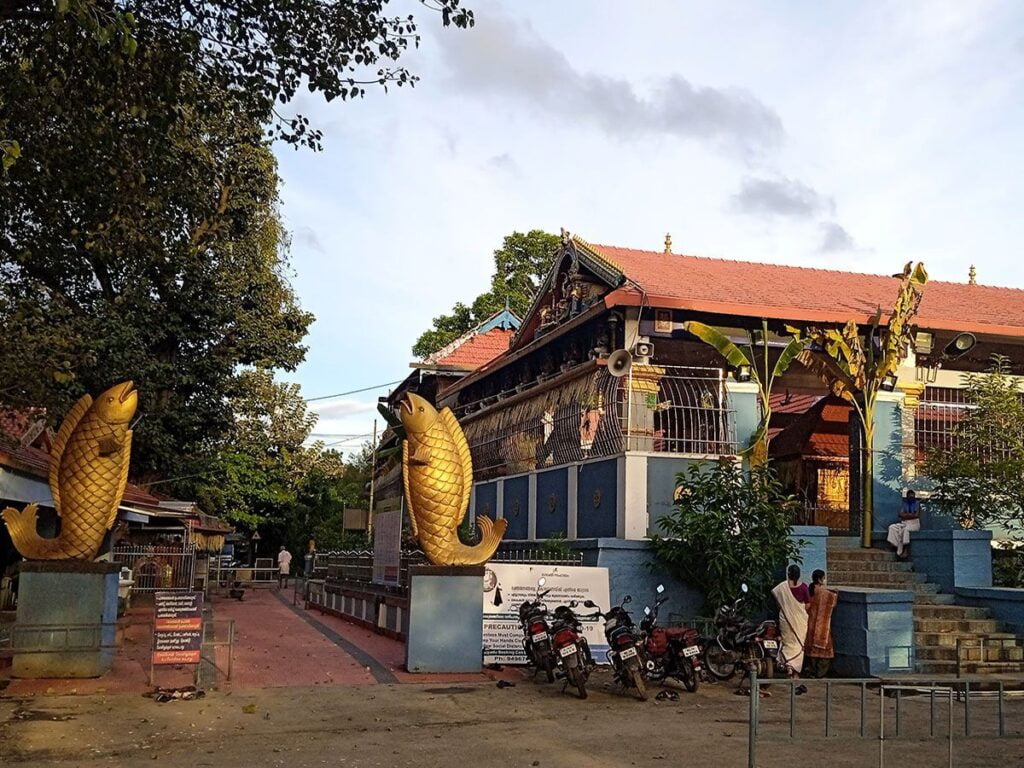
Contents
- 1 Meenkulathi Bhagavathi Amman Temple History:
- 2 Legend Meenkulathi Bhagavathi Amman Temple:
- 3 Significance Meenkulathi Bhagavathi Amman Temple:
- 4 Myths of Meenkulathi Bhagavathi Amman Temple:
- 5 Meenkulathi Bhagavathi Amman Temple Timing and Rituals:
- 6 Places to visit near Meenkulathi Bhagavathi Amman Temple:
- 7 FAQ:
- 8 How to reach Meenkulathi Bhagavathi Amman Temple:
- 9 Google Maps:
Meenkulathi Bhagavathi Amman Temple History:
Origins:
- Legends say the temple is the oldest in Pallassana, a village in Palakkad district, Kerala, India.
- Centuries ago, three families of the Veerasaiva Mannadiar clan worshipped the goddess Meenakshi as their deity.
- A harsh drought in Chidambaram, Tamil Nadu, forced them to migrate seeking better lands.
- One family carried a stone representing Meenakshi, their guiding force, during their journey.
Establishment of the Meenkulathi Bhagavathi Amman Temple:
- After reaching Pallassana, they entrusted the stone to some youths for safekeeping while they explored the area.
- Upon returning, they couldn’t lift the items left with the youths.
- An astrologer attributed this to Meenakshi manifesting herself under the stone, rendering it immovable.
- This event, considered miraculous, drew large crowds, and the place came to be known as Kudamannu.
- Over the next four centuries, the present Meenakshi temple and the adjoining tank were constructed.
Evolution and Significance:
- The Mannadiar clan has grown considerably, and they conduct various festivals like Navarathri, Pongal, and Bhairava.
- The temple is dedicated to Meenakshi, also known as Bhagavathy Amman, and “Meenkulathi” translates to “She who has a tank of fish.”
- The temple is built in the Kerala architectural style and has unique features like walls that don’t cast shadows on the ground.
- It is believed that worshipping here brings prosperity, particularly to businesses.
Read More>> Ameda Temple of Naga Raja
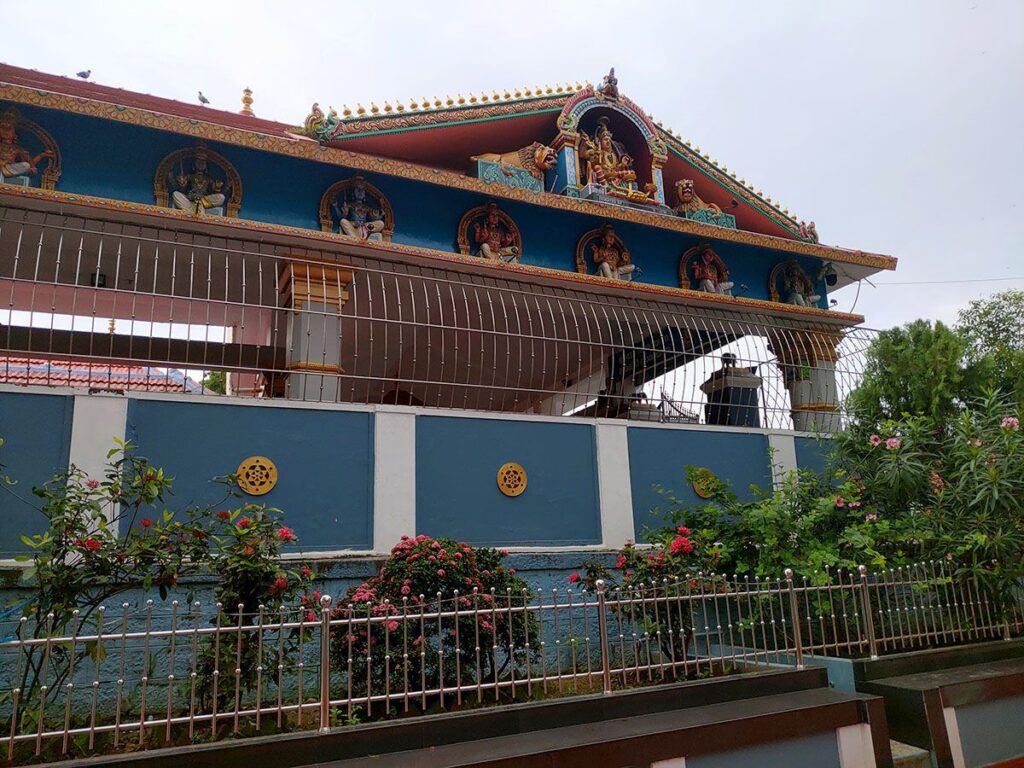
Legend Meenkulathi Bhagavathi Amman Temple:
The Legend of the Three Families
The legend revolves around three families belonging to the Veerasaiva Mannadiar clan who were ardent devotees of Goddess Meenakshi. Due to a severe drought in Chidambaram, Tamil Nadu, they were forced to leave their homeland in search of a better life.
One of the families carried a sacred stone from the Meenakshi Temple in Chidambaram, worshipping it as a symbol of their faith and seeking guidance on their journey. They traveled far and wide, finally settling in Pallassana, enchanted by its verdant forests and the potential for prosperity in the diamond trade.
The Miracle of the Umbrella
As the story goes, the families decided to build a shrine for their beloved goddess Meenakshi. However, when they attempted to move the sacred stone, it miraculously became immovable. An astrologer was consulted, who revealed that the divine presence of Meenakshi herself had manifested under the shade of an umbrella, rendering the stone unmovable.
News of this miraculous event spread far and wide, attracting a multitude of devotees to witness the phenomenon. The location where the stone resided came to be known as “Kundamannu,” meaning “the place where the pot remained.”
Construction of Meenkulathi Bhagavathi Amman Temple:
Over the next four centuries, the Mannadiar clan flourished, and a magnificent temple was constructed around the sacred stone, transforming it into the present-day Meenkulathi Bhagavathi Amman Temple. Additionally, a temple tank was built adjacent to the temple, further enriching the sacred complex.
Read More>> Attukal Temple | Attukal Bhagavathy Temple
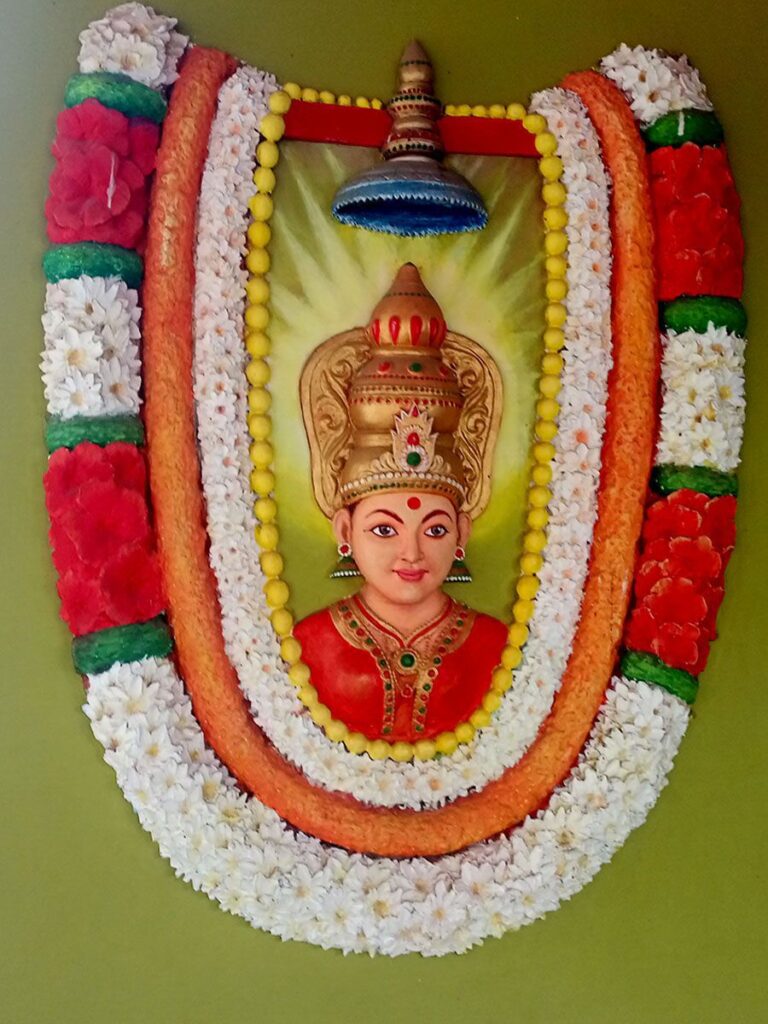
Significance Meenkulathi Bhagavathi Amman Temple:
Historical Significance:
- It is the oldest temple in the village of Pallassana, Kerala, with a history dating back centuries.
- Tradition attributes its origins to three families who migrated from Tamil Nadu due to a drought and brought with them a stone representing their deity, Goddess Meenakshi.
Religious Significance:
- The temple is dedicated to Goddess Bhagavathi Amman, a form of the Hindu mother goddess Durga.
- Devotees believe that the temple and its rituals bring blessings like:
- Protection from evil and misfortune
- Prosperity in business ventures
- Cure for chronic ailments through bathing in the temple tank, which is known for its abundant fish.
Unique Features:
- Meenkulathi Bhagavathi Amman temple’s architecture is built in the Kerala style, with two entrances and a tank located next to the western entrance.
- An interesting feature is that the temple walls are designed in a way that the shadow never falls on the ground.
- The temple observes various festivals throughout the year, with the most prominent one being the “Palli pana” celebrated once every 12 years. This four-day festival includes a fire walking ceremony.
Read More>> Chottanikkara Temple Ernakulam Kerala
Myths of Meenkulathi Bhagavathi Amman Temple:
- Origin story: Legend says three families brought a stone from the Meenakshi Temple in Chidambaram, Tamil Nadu, while migrating due to a drought. They worshipped this stone as their guiding deity and eventually settled in Pallassena, where they prospered in the diamond trade. This stone is believed to be the original form of the Bhagavathi Amman idol worshipped in the temple today. [Source]
- Blessing for business: The Meenkulathi Bhagavathi Amman Temple is particularly popular among business people who believe that seeking blessings from the goddess ensures prosperity and protection from the “evil eye” of envious competitors. A specific ritual involving breaking a coconut is associated with this belief. [Source]
- Resonance of gold: An interesting belief held by some is that the gold adorning the temple’s interiors, especially the idol’s base, resonates with the body’s frequencies, creating harmony and aligning with the “pancha bootha” (five elements) of nature. This belief is not unique to this temple but is found in other South Indian temples as well.
Read More>> 3rd CE Vadakkunnathan Temple Built by Parashurama
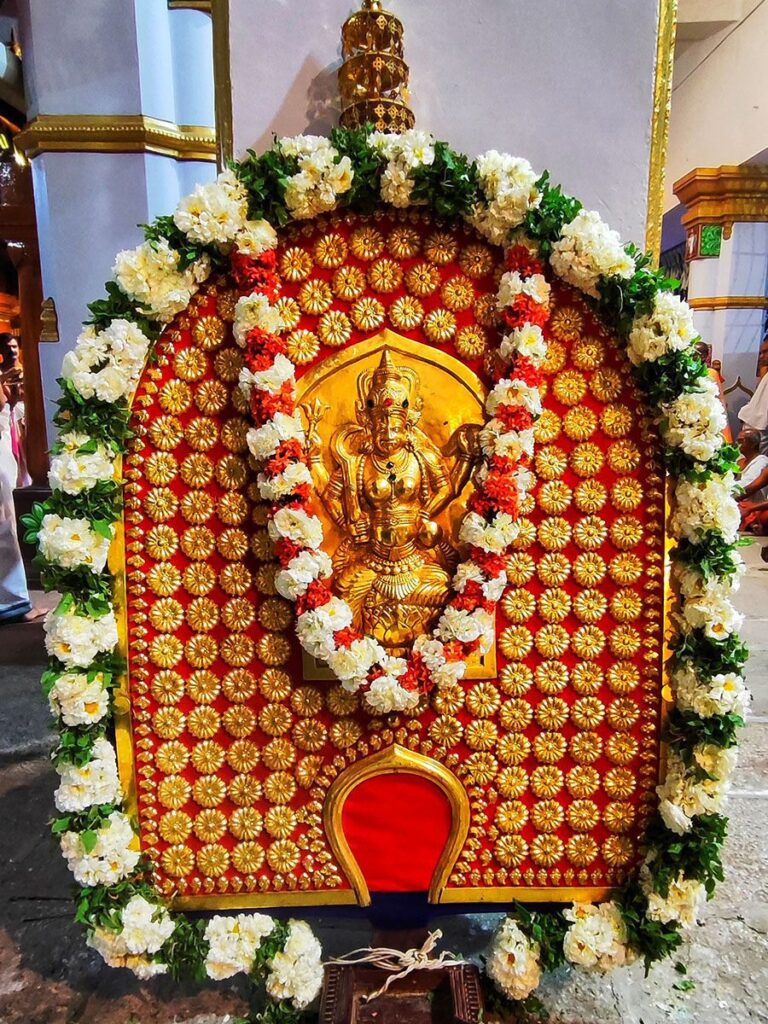
Meenkulathi Bhagavathi Amman Temple Timing and Rituals:
The Meenkulathi Bhagavathi Amman Temple is open from 5:30 AM to 12:30 PM and 5:30 PM to 8 PM. The temple is located in the village of Meenkulathi, in the Thrissur district of Kerala, India.
Morning Darshan
- Sunday, Tuesday, & Friday: 5:30 AM to 12:30 PM
- Other Days: 5:30 AM to 10:30 AM
Evening Darshan: 5:30 PM to 8 PM
Pooja Timings
- Nirmalya Pooja: 5:30 AM
- Usha Pooja: 6:30 AM
- Panchamrut Abhishekam: 7:30 AM
- Kalasabhishekam: 8:30 AM
- Uchcha Pooja: 10:30 AM
- Deeparadhana: 6:30 PM
- Athazha Pooja: 7:30 PM
- Pallivetta: 8:00 PM
Rituals
The Meenkulathi Bhagavathi Amman Temple is a Hindu temple dedicated to the goddess Bhagavathi. The temple is one of the most important temples in Kerala, and it is visited by thousands of devotees every year.
The main ritual performed at the temple is the pooja. The pooja is a ritual offering that is made to the goddess. The pooja is performed by a priest, and it involves the chanting of mantras, the offering of flowers, and the lighting of lamps.
Another important ritual performed at the temple is the abhishekam. The abhishekam is a ritual bath that is performed for the goddess. The abhishekam is performed with milk, ghee, honey, and other sacred substances.
The Meenkulathi Bhagavathi Amman Temple also celebrates a number of festivals throughout the year. The most important festival is the Navarathri festival. The Navarathri festival is a nine-day festival that celebrates the victory of good over evil. During the festival, the temple is decorated with lights and flowers, and special poojas are performed.
Read More>> Thiruvairanikulam Mahadeva Temple
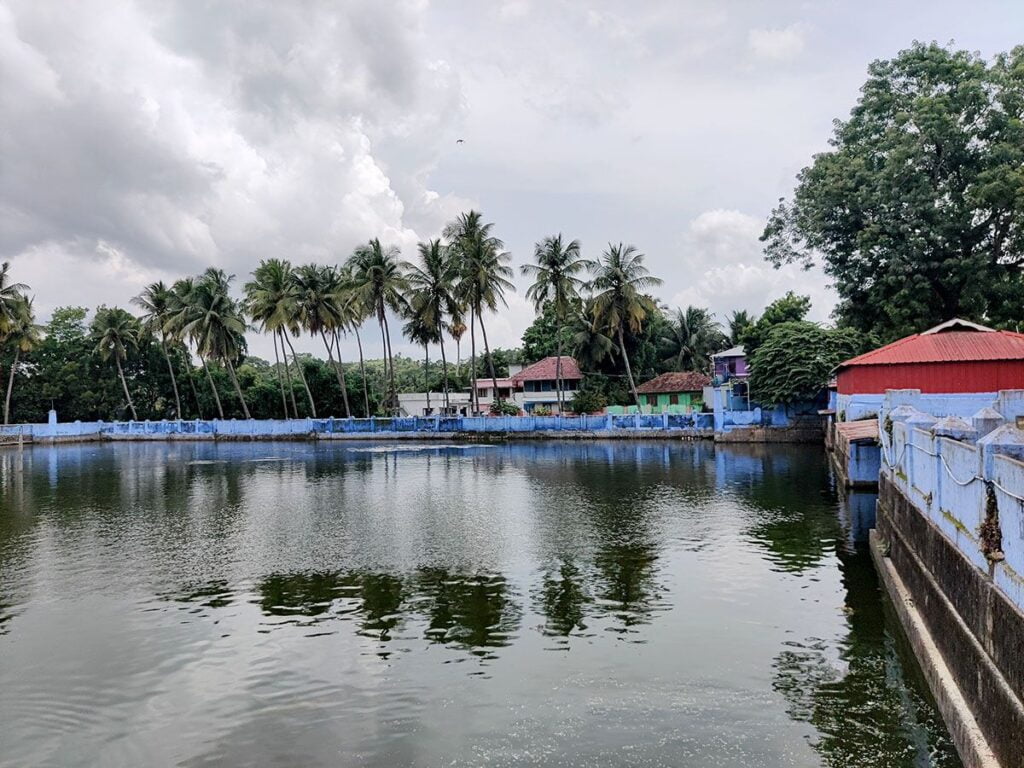
Places to visit near Meenkulathi Bhagavathi Amman Temple:
- Palakkad Fort: Explore the historic Palakkad Fort, also known as Tipu’s Fort. It’s a well-preserved fort with a mix of Kerala and Mughal architectural styles.
- Malampuzha Dam and Gardens: Enjoy the scenic beauty of Malampuzha Dam, visit the gardens, and take a boat ride. There’s also a ropeway and a snake park nearby.
- Parambikulam Wildlife Sanctuary: If you’re a nature enthusiast, consider visiting Parambikulam Wildlife Sanctuary, known for its rich biodiversity and lush greenery.
- Silent Valley National Park: Located a bit further away, Silent Valley National Park is known for its pristine tropical rainforests and diverse flora and fauna.
- Nelliyampathy: This hill station offers panoramic views of the Western Ghats. You can explore tea plantations, waterfalls, and go on trekking trails.
- Dhoni Waterfalls: It’s a beautiful waterfall located near Palakkad, offering a serene and refreshing atmosphere.
- Jainimedu Jain Temple: Visit this ancient Jain temple known for its unique architecture and historical significance.
- Kava: Kava is a scenic spot nestled amidst hills and forests, providing a tranquil escape.
FAQ:
History & Legend
- Q. What is the origin story of the temple?
- A. Legend says three Veerasaiva Mannadiar families brought a stone representing Goddess Meenakshi from Chidambaram during a drought. This stone miraculously became fixed to the ground, and the Meenkulathi Bhagavathi Amman Temple was built around it.
- Q. Who is the main deity worshipped?
- A. The main deity is Meenakshi Amman, a form of Parvati.
Temple Structure & Darshan
- Q. What is the architectural style of the temple?
- A. The temple is built in the Kerala style, with features like a shadowless wall and two entrances.
- Q. Can I circumambulate (walk around) the sanctum sanctorum?
- A. No, devotees are not allowed to go around the sanctum sanctorum due to the presence of other deities.
Temple Timings & Festivals
- Q. What are the temple opening hours?
- A. Timings differ by day. Generally, it’s open 5:30 AM to 12:30 PM on Sundays, Tuesdays, and Fridays, and 5:30 AM to 10:30 AM on other days. It reopens in the evening from 5:30 PM to 8 PM.
- Q. What are the major festivals celebrated here?
- A. Navaratri, Karthiga, Mandala Vilakku, foundation day, Palli Vettai, and Vaira pooja are some of the important festivals.
Additional Information
- Q. Is there a temple tank?
- A. Yes, there is a temple tank next to the western entrance, where devotees can bathe before entering the temple.
- Q. Where is the temple located?
- A. The Meenkulathi Bhagavathi Amman Temple is situated in Pallassana village, Palakkad District, Kerala, on the road connecting Palakkad and Kollengode.
How to reach Meenkulathi Bhagavathi Amman Temple:
By Air:
The nearest major airport to Palakkad is Coimbatore International Airport (CJB) in Tamil Nadu, which is approximately 55 kilometers away. From the airport, you can hire a taxi or use other local transportation to reach Palakkad.
By Train:
Palakkad Junction Railway Station is a major railway station in the region and is well-connected to various cities in India. You can check the train schedules and book tickets through the official Indian Railways website or other online platforms.
By Road:
- From Coimbatore:
- Palakkad is approximately 50 kilometers from Coimbatore. You can hire a taxi or use buses that ply between the two cities.
- From Thrissur:
- If you are coming from the south, Thrissur is a major city relatively close to Palakkad. You can reach Palakkad by road using buses or taxis.
- By Bus:
- Palakkad has a well-developed bus network connecting it to various cities in Kerala and neighboring states. You can find both government and private buses plying to Palakkad.
